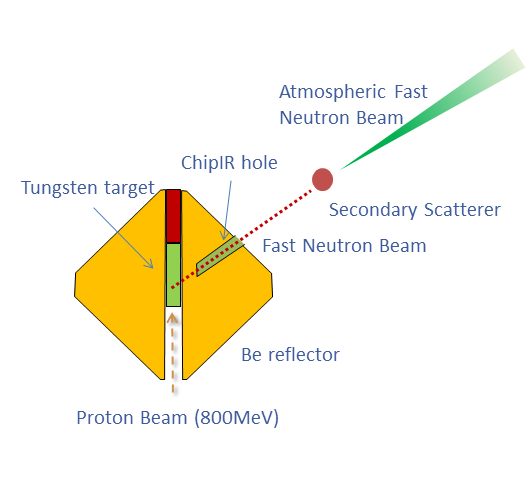Rapid testing of Single Event Effects with atmospheric-like neutrons
ChipIr is a new beamline dedicated to the irradiation of microelectronics with atmospheric-like neutrons; it has been built on the second target station of the ISIS spallation source at the Rutherford Appleton Laboratory, UK. The beamline is specifically dedicated to the study of single event effects and its design is therefore optimized to extract a neutron spectrum as similar as possible to the atmospheric one with intensity increased by a factor up to 109 depending on configuration. The ChipIr neutron flux (with En>10 MeV) has been measured to be 5 · 106 cm-2s-1.
“These high energy neutrons and protons are problematic because they interact with semiconductor material – on the ground or aboard aircraft –where they give rise to lower energy protons nuclear recoils and other secondary charged particles. These deposit a small amount of electronic charge causing SEE's"
Royal Academy of Engineering, Extreme space weather: impacts on engineered systems and infrastructure.
.jpg)
|
The ChipIr team Dr Chris Frost and Dr Carlo Cazzaniga |
The main challenge in the design of ChipIr was that the ISIS target station is primarily used to simultaneously deliver thermal and cold neutrons (in the meV energy range) by means of hydrogenous moderators to a variety of instruments for the purpose of condensed matter science. ChipIr is the first instrument on this, or any other similar target station to extract a fast neutron spectrum E
n >1 MeV) from such a source. To extract a fast neutron beamline, a new section with a channel had to be inserted in the beryllium reflector for the ChipIr line of sight. Neutrons from this channel illuminate a secondary scatterer made to optimize the hard atmospheric-like neutron spectrum.

|
The ChipIr neutron spectrum (up to 800 MeV) compared to the atmospheric spectrum at Ground Level. |
ChipIr, as every beamline at the ISIS source, has an independent shutter, so that its neutron beam can be closed and opened while the accelerator is running.

|
Schematics of the neutronics components needed to produce the ChipIr atmospheric neutron beam.
|
One of the key aspects of the commissioning is the measurements of the ChipIr beam profile. A collimator system allows for selecting beams of different sizes, from 1m x 1m down to a few cm2. At present (Nov 2017) the tested collimator configuration defines a collimated beam of 70 × 70 mm2. This dimension was chosen because it provides a typical configuration for electronic device irradiation. A map of the beam was measured using the diamond detector mounted on the XY stage. We demonstrated that this 70 × 70 mm2 is uniform and the footprint of the beam is square. This is shown by the map in the figure. It should be noted that there is a good ratio, almost three orders of magnitude, between the centre of the beam and the penumbra.

|
Map of the 70 × 70 mm2 ChipIr beam measured with a Diamond Detector.
|
